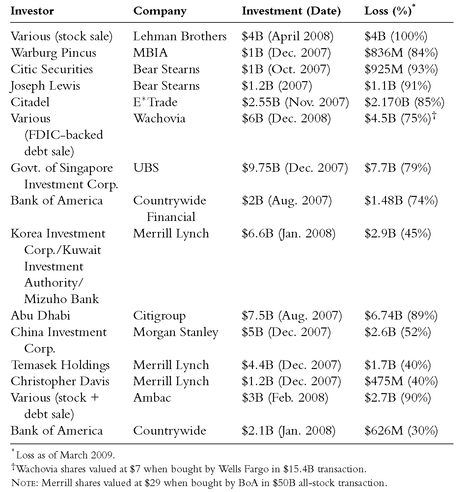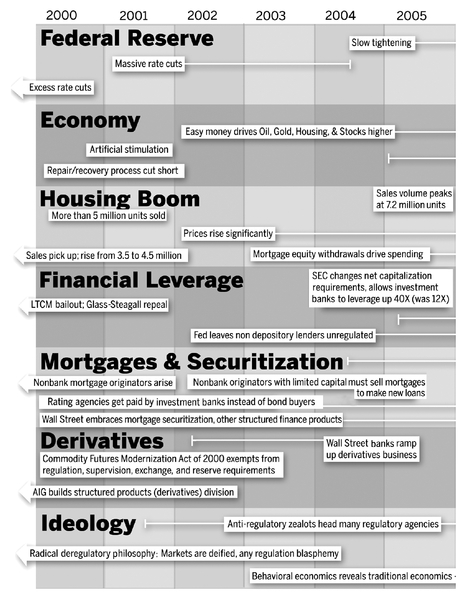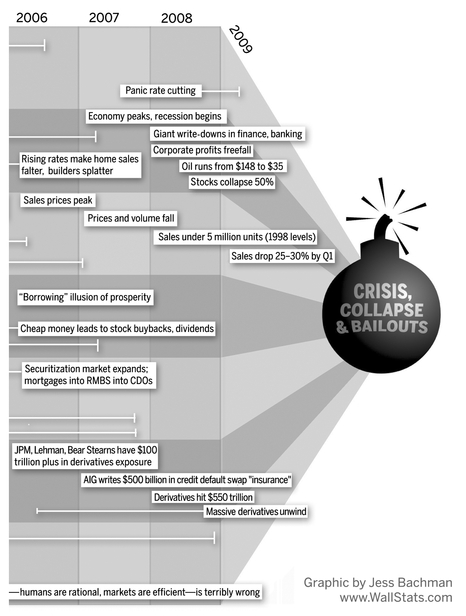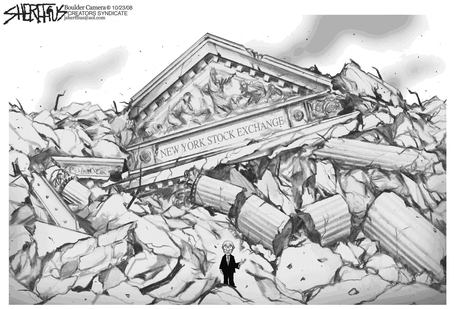Bailout Nation (27 page)
Authors: Barry Ritholtz

Once the auto bailout lost in the Senate, the White House said the government was likely to make an emergency loan to GM, Ford, and Chrysler out of TARP. Well, I guess if you think about it, the automakers
are
“troubled assets”âbut that's hardly what was contemplated by the term when Congress originally approved the $700 billion emergency fund.
5
are
“troubled assets”âbut that's hardly what was contemplated by the term when Congress originally approved the $700 billion emergency fund.
5
How typically corrosive and corrupting a big pile of money can be. This is yet another downside of bailouts: It brings the leeches and vultures, mostly in the form of lobbyists, seeking to grab a slice of that sweet pork pie.
And that's before we even consider what other, worthwhile programs will be squeezed out by the bailouts' terrible financial costs.
How to Pay for National Health Insurance
Since the government has spent such an inordinate amount of taxpayer money cleaning up after Wall Street's so-called best and brightest and the mess they made, there is not a whole lot of money left over for other new programs.
Once such legislative work was national health insurance. Surveys have shown that a significant majority of Americans support it. It was one of the key planks of Barack Obama's presidential campaign.
Well, no worries over the lack of funding for health care. There is a simple way to ensure that every man, woman, and child in the United States is covered by health care insurance. Taking a page from the cleverest of Wall Street's financial engineers, all it takes is a little of that Street magic and derivative-based hocus-pocus in seven steps:
1. Set up a large, well-capitalized hedge fund. About $5 billion should do it.
2. The prospectus of the fund should note its purpose is to “seek out profit opportunities via arbitraging inefficiencies in the markets and health care system of the United States.” Include standard socially conscious fund language with clauses such as “We plan to do well by doing good.”
3. Launch the fundâand promptly max out your leverage. The credit crisis makes it difficult to go 50 to 1, but 10 or 20 to 1 should not be much of a problem.
4. Use the money to write credit default swaps with a notional value of $3 trillion. The premiums on these CDSs should be about 10 percent to 15 percent or so.
5. Roll over the cash premiumsâabout $350 billion worthâinto a national fund. Use it to buy health care insurance for all U.S. citizens!
6. Send certified letters to your counterparties, declaring that due to the unfortunate current credit conditions, you will be defaulting on these CDSs. Be sure to mention that a significant amount of your CDS paper is held by JPMorgan and Citigroup. Another trillion is held by China and Japan, with other sovereign wealth funds owning the rest.
7. Send out a press release announcing “systemic risk.” Tell the Treasury secretary and the Federal Reserve chair that your imminent collapse will wreak global havoc. Apply for bailout.
Congratulations! You have national health care!
Repeat for any major government program: alternative energy research, school vouchers, Mars mission, global warming, or missile defense shield.
In the future, this is how all government spending programs will be funded.

T
he other danger that moral hazard presents is to allow investors to mistakenly believe a paternal Fed will always be there to bail them out of any jams. Some evidence of this can be seen in the behavior of several well-known funds and famous investors. In 2007 and 2008, they placed a series of large bets in the financial sector. Some purchased investment banks with long, storied histories and pedigreed founders. Others jumped into the mortgage business, buying firms that specialized in underwriting, origination, or securitization. Still others have scooped up bank shares at prices that were perceived to be on the cheap.
he other danger that moral hazard presents is to allow investors to mistakenly believe a paternal Fed will always be there to bail them out of any jams. Some evidence of this can be seen in the behavior of several well-known funds and famous investors. In 2007 and 2008, they placed a series of large bets in the financial sector. Some purchased investment banks with long, storied histories and pedigreed founders. Others jumped into the mortgage business, buying firms that specialized in underwriting, origination, or securitization. Still others have scooped up bank shares at prices that were perceived to be on the cheap.
What were originally thought to be bargains turned out instead to be quite pricey. Losses have ranged from the merely enormous to the utterly devastating. Of the approximately $57.3 billion in high-profile investments tallied in
Table 13.1
, an international group of presumably savvy investors had suffered a collective loss of about 75 percent as of December 2008.
Table 13.1
, an international group of presumably savvy investors had suffered a collective loss of about 75 percent as of December 2008.
Note: These devastating losses are ongoingâand seemingly getting worse all the time
.
.
Table 13.1
You Call That “Smart Money”?
You Call That “Smart Money”?
SOURCE: Published reports, Yahoo! Finance

How did otherwise intelligent, experienced investors find themselves on the wrong side of these trades? These were not mere stock-picking foibles of the “win some, lose some” variety. Rather, they were catastrophes that had nothing to do with these investors' ability to read complex balance sheets, or assess financial leverage, or recognize counterparty risks. These investment losses did not come about based on some unforeseen macroeconomic challenge to a company's business model.
No, the problem that these investors encountered was one of misplaced confidence. It's yet another risk that is run when investors perceive that the government is there to rescue them. These fund managers made the simple mistake of placing their faith in the central bank of the United States of America. Inspired at first by the Federal Reserve, and then subsequently by the Treasury, these formerly savvy traders rushed headlong into the U.S. financial sector, regardless of what proved to be readily apparent risks.
These turned out to be exquisitely expensive mistakes.
Indeed, one of the more fascinating aspects of the Fed's intervention in the financial markets has been the impact it has had on the psyches of some of its largest players.
This is another consequence of moral hazard. By creating a perceived readiness to bail out markets and speculators, central banks run the risk that they can perversely end up encouraging even more risk taking by other market participants. The bravado and false confidence the Fed's intervention engendered led quite a few funds down the wrong path. This rise in false confidence among those who should otherwise know better is merely another aspect of moral hazard.
It can be argued that these misguided rescue operations made the financial system
more
unstable by encouraging greater recklessness and additional risk taking (see
Figure 13.1
). All the while, the speculators' profits remain their own, while the risks are born by the taxpayers.
more
unstable by encouraging greater recklessness and additional risk taking (see
Figure 13.1
). All the while, the speculators' profits remain their own, while the risks are born by the taxpayers.
The smart money was proven in 2008 to be not so smart after all. The very expensive costs were summed up by an anonymous trader who e-mailed a colleague: “This has been even worse than my first divorce. I've lost half my net worth but I still have my wife.”
Wall Street gallows humor being what it is, the e-mail circulated far and wide among trading desks. But that's a wholly different kind of moral hazard.
Figure 13.1
The Anatomy of a Collapse
The Anatomy of a Collapse


Part IV
BAILOUT NATION
“I have found a flaw.” - Alan Greenspan
Source
: By permission of John Sherffius and Creators Syndicate, Inc.
: By permission of John Sherffius and Creators Syndicate, Inc.

Chapter 14
2008: Suicide by Democracy
Remember, democracy never lasts long. It soon wastes, exhausts, and murders itself. There never was a democracy yet that did not commit suicide.
âJohn Adams
Â
Â
H
ow did the once proudly independent United States become a Bailout Nation? The first modest government interventions and legislative fixes soon changed to far more insidious corporate welfare. What once was unthinkable slowly morphed into something merely undesirable on its way to becoming the least bad option facing policy makers. The cumulative effect has been a creeping paternalism, rife with moral hazard.
ow did the once proudly independent United States become a Bailout Nation? The first modest government interventions and legislative fixes soon changed to far more insidious corporate welfare. What once was unthinkable slowly morphed into something merely undesirable on its way to becoming the least bad option facing policy makers. The cumulative effect has been a creeping paternalism, rife with moral hazard.
During the debates about earlier bailouts, be they Lockheed in 1971 or Chrysler in 1980, the language and philosophy were very different from the 2008 Troubled Assets Relief Program (TARP) debate. Historically, there was a legitimate battle between ideologies as to whether any bailout should be enacted in a market-based economy. Concern about the negative future ramifications of these bailouts was paramount. The bailout discussion circa 2008 was long on fearmongering and short on substantive issues. Lawmakers were presented with a “Trust me” document, then hardly given a chance to read it. “Vote for this or suffer horrific consequences to the entire financial system” was the administration's approach.
How did this philosophical shift take place? Philosophically, the politics, economics, and financial analysis of bailouts have shifted dramatically since the 1970s. What makes this so ironic is the rightward political shift of the same era. Since Ronald Reagan was elected president in 1980, Republicans have ascended to power at the federal and state levels. The GOP won the White House in five of the seven elections from 1980 to 2008. The Republicans controlled Congress from 1994 to 2006. One might imagine that a conservative president and a rightward-leaning Congress would boldly object to bailout after bailout.
Other books
The Charmers by Stella Gibbons
La mujer del viajero en el tiempo by Audrey Niffenegger
Catch a Falling Clown: A Toby Peters Mystery (Book Seven) by Stuart M. Kaminsky
Five on a Treasure Island by Enid Blyton
Glass Houses by Jane Haddam
Unforgettable: Always 2 by Cherie M Hudson
Obsessive Compulsive Disorder by Polly Waite
Unforgettable by Reynolds, Abby
Winged Warfare by William Avery Bishop
